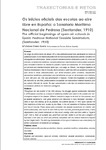Mostrar o rexistro simple do ítem
Os inicios oficiais das escolas ao aire libre en España: o Sanatorio Marítimo Nacional de Pedrosa (Santander, 1910)
| dc.contributor.author | Cotelo-Guerra, Dolores | |
| dc.date.accessioned | 2011-07-12T10:20:32Z | |
| dc.date.available | 2011-07-12T10:20:32Z | |
| dc.date.issued | 2009 | |
| dc.identifier.citation | Ambientalmente Sustentable, 2009, 8: 87-119. ISSN: 1887-2417 | es_ES |
| dc.identifier.issn | 1887-2417 | |
| dc.identifier.uri | http://hdl.handle.net/2183/7408 | |
| dc.description.abstract | [Resumo] Ao longo do último tercio do século XIX a loita antituberculosa foise acentuando en todos os países europeos como medida de protección á infancia que se atopaba en período curable e non propagable da enfermidade. Vanse fundando establecementos destinados a este fin, como por exemplo, os sanatorios marítimos -con gran presenza e importancia en moitos países europeos- para combater e destruír na medida do posible o bacilo da tuberculose. En 1910 España abre por primeira vez establecementos deste tipo, con cargo ao Estado, nos antigos lazaretos de Pedrosa (Santander) e Oza (A Coruña), reconvertidos a partir de entón en sanatorios marítimos para nenos e nenas pretuberculosos, que serían enviados polos concellos, deputacións, asociacións benéficas e particulares para beneficiarse do que se denominaba cura hixiénica; é dicir, aire puro, sol, mar, boa alimentación e repouso. A todo isto engadíase un programa de instrución ao aire libre, perfectamente compatible cos tratamentos médicos impostos polo seu estado delicado de saúde. Se algo caracterizaba a este tipo de establecementos era a combinación perfecta de medicina e pedagoxía. | es_ES |
| dc.description.abstract | [Abstract] Throughout the last quarter of the 19th century, the struggle against tuberculosis intensified in all European countries as a means of protecting children who were in the curable and non- contagious stages of the disease. Different institutions began to be built for this purpose, such as seaside sanatoriums -with great presence and relevance in many European countries- in order to fight and destroy, as far as possible, the tubercle bacillus. In 1910 Spain opened the first institutions of this kind, funded by the State, in the old lazarettos of Pedrosa (Santander) and Oza (A Coruña). These places were converted into seaside sanatoriums for children with latent tuberculosis, who would be sent there by town councils, provincial governments, charity organizations and private individuals so they could undergo what was then called a “hygiene cure”, that is, fresh air, sunlight, sea, good food and rest. Added to all this was a program of education in the open air, which was perfectly compatible with the medical treatments required by their fragile health. The defining characteristic of this type of institutions was undoubtedly the perfect combination of medicine and pedagogy. | es_ES |
| dc.language.iso | glg | es_ES |
| dc.publisher | Universidade da Coruña | es_ES |
| dc.subject | Hixiene e educación | es_ES |
| dc.subject | Escolas ao aire libre | es_ES |
| dc.subject | Infancia | es_ES |
| dc.subject | Sanatorio marítimo | es_ES |
| dc.subject | Tuberculose | es_ES |
| dc.subject | Colonias escolares | es_ES |
| dc.subject | Hygiene and education | es_ES |
| dc.subject | Open-air schools | es_ES |
| dc.subject | Childhood | es_ES |
| dc.subject | Seaside sanatorium | es_ES |
| dc.subject | Tuberculosis | es_ES |
| dc.subject | School colonies | es_ES |
| dc.title | Os inicios oficiais das escolas ao aire libre en España: o Sanatorio Marítimo Nacional de Pedrosa (Santander, 1910) | es_ES |
| dc.type | info:eu-repo/semantics/article | es_ES |
| dc.rights.access | info:eu-repo/semantics/openAccess |






